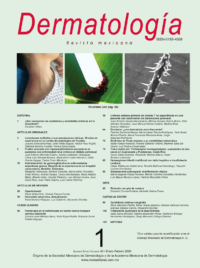Dermatol Rev Mex. 2020 enero-febrero;64(1):80-85.
Felipe Velásquez-Valderrama,1 Rosalía Ballona-Chambergo,2 Yaquelin Condori-Fernández3
1 Médico asistente del Servicio de Dermatología,
2 Jefe del Servicio de Dermatología.
Instituto Nacional de Salud del Niño, Breña, Lima, Perú.
3 Médico residente de Dermatología, Hospital Vitarte, Universidad Privada San Juan Bautista, Lima, Perú.
Resumen
ANTECEDENTES: El hemangioma infantil es el tumor benigno más frecuente de la infancia, con incidencia de 4 a 10% en menores de un año. Según su profundidad se clasifican en superficiales, profundos y mixtos y según su patrón, forma o distribución en focales, segmentarios, indeterminados y multifocales. La existencia de cinco o más hemangiomas cutáneos nos obliga a descartar afectación visceral, la localización hepática es la más frecuente. Los hemangiomas hepáticos multifocales pueden producir mortalidad significativa por complicaciones como la insuficiencia cardiaca.
CASO CLÍNICO: Paciente femenina de un mes de nacida con múltiples (835) hemangiomas cutáneos superficiales de distribución universal, afectación hepática multifocal e insuficiencia cardiaca relacionada con una comunicación interauricular de nacimiento.
CONCLUSIONES: La identificación de hemangiomas multifocales debe alertarnos respecto a un posible daño visceral y sus complicaciones, por lo que debe realizarse un abordaje multidisciplinario, prescribir tratamiento de manera temprana y tener vigilancia estrecha, lo que mejora el pronóstico y la calidad de vida de los pacientes.
PALABRAS CLAVE: Hemangioma infantil; hemangiomas hepáticos; hemangiomas cutáneos; insuficiencia cardiaca.
Abstract
BACKGROUND: Infantile hemangioma is the most common benign tumor of infancy with an incidence of 4 to 10% in children under one year of age. According to its depth, it is classified as superficial, deep and mixed, and according to its pattern, shape or distribution in focal, segmental, indeterminate and multifocal. The presence of more than five cutaneous hemangiomas forces us to rule out visceral involvement, liver is the most frequent location. Multifocal hepatic hemangiomas can produce significant mortality due to complications such as heart failure.
CLINICAL CASE: A 1-month-old female patient with multiple (835) superficial cutaneous hemangiomas of universal distribution with multifocal hepatic involvement and heart failure associated to an atrial septal defect at birth.
CONCLUSION: The identification of multifocal hemangiomas should alert us about the possibility of visceral involvement and its complications, we must perform a multidisciplinary approach as well as early treatment with close monitoring, in order to improve the prognosis and quality of life of patients.
KEYWORDS: Infantile hemangioma; Hepatic hemangiomas; Cutaneous hemangiomas; Heart failure.

